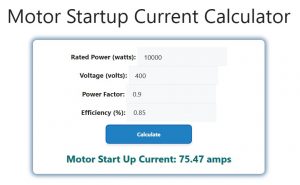About Motor Startup Current Calculator (Formula)
The Motor Startup Current Calculator is a valuable tool for electrical engineers and technicians working with electric motors. When electric motors start, they draw a significantly higher current compared to their running current. This initial surge of current, known as the startup current, can be several times higher than the motor’s normal operating current. Understanding and calculating this startup current is essential for ensuring that electrical systems can handle the load, preventing potential damage and ensuring efficient operation.
Formula
The formula for calculating the startup current (Isu) is:
Isu = 4 * (RP / (√3 * V * PF * E))
Where:
- Isu is the startup current.
- RP is the rated power of the motor in watts.
- V is the line voltage.
- PF is the power factor.
- E is the efficiency of the motor.
How to Use
Using the Motor Startup Current Calculator involves a few simple steps:
- Gather Information: Collect the necessary data for the motor, including its rated power, line voltage, power factor, and efficiency.
- Input Values: Enter the gathered values into the calculator:
- Rated power (RP) in watts
- Line voltage (V) in volts
- Power factor (PF) as a decimal (e.g., 0.85)
- Efficiency (E) as a decimal (e.g., 0.9)
- Calculate: The calculator will compute the startup current using the provided formula.
- Analyze Results: Review the calculated startup current to ensure that it is within the acceptable limits for your electrical system.
Example
To illustrate how to use the Motor Startup Current Calculator, let’s consider an example.
Assume you have a motor with the following specifications:
- Rated power (RP): 10,000 watts
- Line voltage (V): 400 volts
- Power factor (PF): 0.9
- Efficiency (E): 0.85
Using the formula:
Isu = 4 * (RP / (√3 * V * PF * E))
Plugging in the values:
Isu = 4 * (10,000 / (√3 * 400 * 0.9 * 0.85))
Isu = 4 * (10,000 / (1.732 * 400 * 0.765))
Isu = 4 * (10,000 / 531.48)
Isu = 4 * 18.82
Isu ≈ 75.28 A
The calculated startup current for this motor is approximately 75.28 amperes.

FAQs
- What is startup current?
Startup current is the initial surge of current drawn by an electric motor when it is powered on. - Why is it important to calculate startup current?
Calculating startup current helps ensure that electrical systems can handle the load and prevents potential damage to components. - How does startup current differ from running current?
Startup current is typically much higher than running current, often several times greater, depending on the motor type and load. - What factors affect startup current?
Factors include the motor’s rated power, line voltage, power factor, and efficiency. - Can high startup current damage electrical components?
Yes, excessive startup current can cause overheating, tripping breakers, and damaging electrical components. - What is the typical range for startup current?
Startup current can range from 4 to 8 times the motor’s running current, depending on the motor type and load. - How can I reduce startup current?
Methods include using soft starters, variable frequency drives (VFDs), or reducing the load during startup. - What is the difference between startup current and inrush current?
Startup current is the current drawn immediately upon startup, while inrush current may include additional current drawn during the initial operation of the motor. - How often should I calculate startup current?
It is advisable to calculate startup current whenever a new motor is installed or if existing motors are modified or replaced. - Is this calculator suitable for all motor types?
Yes, the calculator can be used for various types of electric motors, including induction motors and synchronous motors. - What is the role of power factor in calculating startup current?
The power factor indicates how effectively the motor converts electrical power into mechanical power, influencing the startup current calculation. - How does efficiency affect startup current?
Higher efficiency reduces the amount of energy lost, leading to lower startup current values. - What happens if the startup current exceeds the system’s capacity?
If the startup current exceeds the capacity, it can lead to tripped circuit breakers, blown fuses, or damaged electrical components. - Can I use this calculator for three-phase motors?
Yes, this calculator is designed for three-phase motors, as indicated by the use of the √3 factor in the formula. - What should I do if my calculated startup current is too high?
Consider implementing soft starters, VFDs, or checking the motor’s load conditions to manage the startup current. - How do I determine the rated power of my motor?
The rated power is typically specified on the motor’s nameplate or in the manufacturer’s documentation. - What is the significance of line voltage in this calculation?
Line voltage affects the current flow; higher voltage typically results in lower startup current. - Can this calculator be used for single-phase motors?
This specific formula is tailored for three-phase motors, but similar principles can be applied to single-phase motors with adjustments. - How does the size of the motor impact startup current?
Larger motors generally have higher startup currents due to increased inertia and load requirements. - What maintenance practices can help manage startup current issues?
Regular maintenance, including checking connections, lubrication, and ensuring the motor operates within specified limits, can help mitigate issues related to startup current.
Conclusion
The Motor Startup Current Calculator is a vital tool for anyone involved in the installation and maintenance of electric motors. By accurately calculating the startup current, users can ensure that their electrical systems are adequately equipped to handle the initial load, preventing equipment failure and ensuring reliable operation. Understanding the factors that influence startup current, such as power factor and efficiency, allows for better planning and management of motor-driven applications, ultimately enhancing overall system performance.